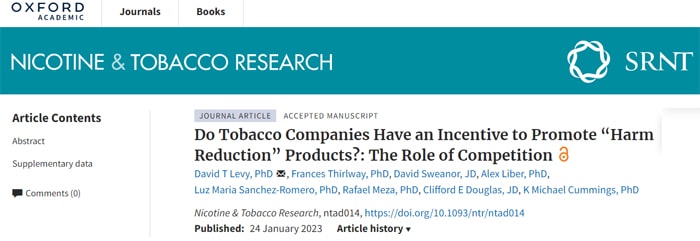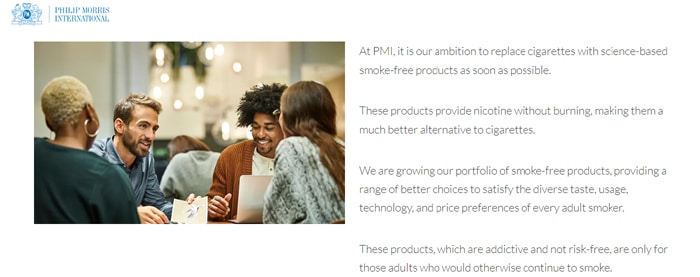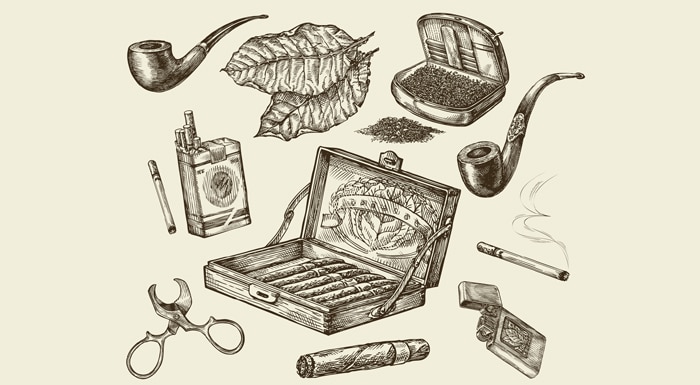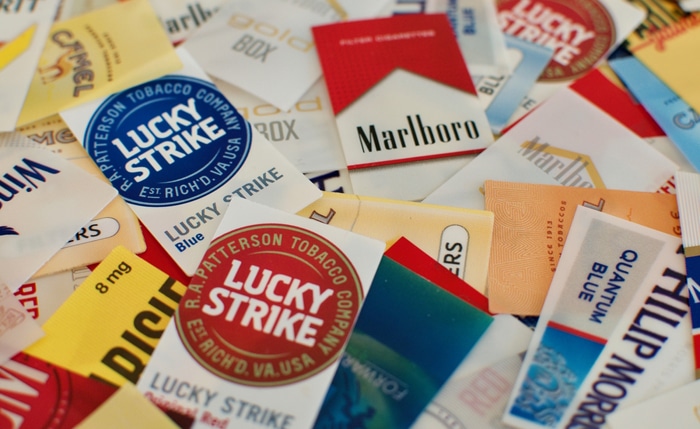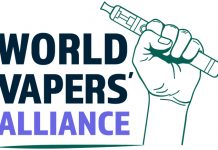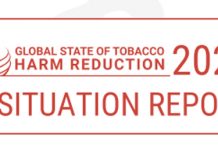A new study has been published titled “Do Tobacco Companies Have an Incentive to Promote “Harm Reduction” Products? : The Role of Competition”. Catchy huh!
You can also view the full PDF here.
Introduction
The background to this study is to investigate the motives of large tobacco companies who have been showing interest in tobacco harm reduction. For instance those who create their own NVP (Nicotine Vaping Products), Heated Tobacco Products (HTPs) and Oral Nicotine Delivery Products (ONDPs).
For instance the large tobacco company Philip Morris International (PMI) have produced the IQOS heated tobacco product, plus the SHIRO pouches and IQOS VEEV and BEEVA vape devices. The company have pledged to replace their cigarette products with combustion free products as soon as possible.
Also Altria (formerly part of PMI but now a separate company) have stated
“We’re building a diversified business model with smoke-free products to further our harm reduction goals and achieve our Vision by 2030 to responsibly lead the transition of adult smokers to a smoke-free future.”
Are these changes of mood down to competition? i.e. cigarette and tobacco sales falling so the big tobacco companies wanting a slice of the pie of emerging novel tobacco sales.
According to the report since 2006 the use of novel tobacco products (non combustibles such as NVP, HTP, ONDP) has risen and US cigarette companies have acquired major stakes in each category.
The study believes that cigarette companies are more biased towards HTP and ONDP rather than vapes but will they change this to compete in the lucrative NVP market.
Authors analysed the incentives towards harm reduction from a profit maximising point of view – whether it is worth them moving away from current tobacco products towards non combustibles.
The study states…
“While cigarette companies will back alternatives to combusted tobacco when threatened by competition, the prospects for their lasting conversion to NCNDPs (Non Combustible Nicotine Delivery Systems) will depend on the extent of such competition, which will be influenced by government regulation of tobacco products.”
Conclusions
The paper says that local regulations will have a big impact on large companies transitioning to harm reduction products.
“Regulations that limit competition from independent firms while also protecting cigarette company profits risk slowing or even reversing recent declines in smoking, especially among youth and young adults. Regulations that reduce the appeal and addictiveness of combusted tobacco products, such as higher cigarette taxes or a reduced nicotine standard, will encourage smokers to quit and/or switch to less harmful non-combusted forms of tobacco. The regulation of non combustible nicotine delivery products and cigarettes should be proportionate to their relative risks, so that smokers have incentives to switch from combustibles to safer alternatives, and cigarette companies have incentives to promote safer products.”
The behaviour of tobacco companies was analysed for pre and post 2012 time periods and also the profits and devices on offer were noted.
Around 2006 the study states that consumers and tobacco companies started to notice alternative nicotine delivery products.
During that time and prior to 2012 cigarette companies started buying firms producing alternative tobacco products to keep in the market.
However after 2012 when the novel tobacco products gained popularity, in particular vapes, the tobacco companies were experiencing significant competition which they had not faced before.
Tobacco companies started to buy up companies producing Snuff and also Cigar companies.
Around 2013-2018 the tobacco market was hit with decreasing sales and then started to move towards Vaping and HTPs.
Also post 2012 the price increases in tobacco had for one of the first times impacted their sale with people having access to cheaper and safer nicotine delivery products. Vaping products in particular were manufactured by many different companies which were independent of the Tobacco giants and they could not purchase all of them!
So from 2012 onward you see cigarette companies started acquiring vape and HTPs companies and even producing their own.
One of the leading vape companies Juul had the tobacco company Altria purchase a major stake again showing how tobacco companies felt the pressure of competition and decrease in sales.
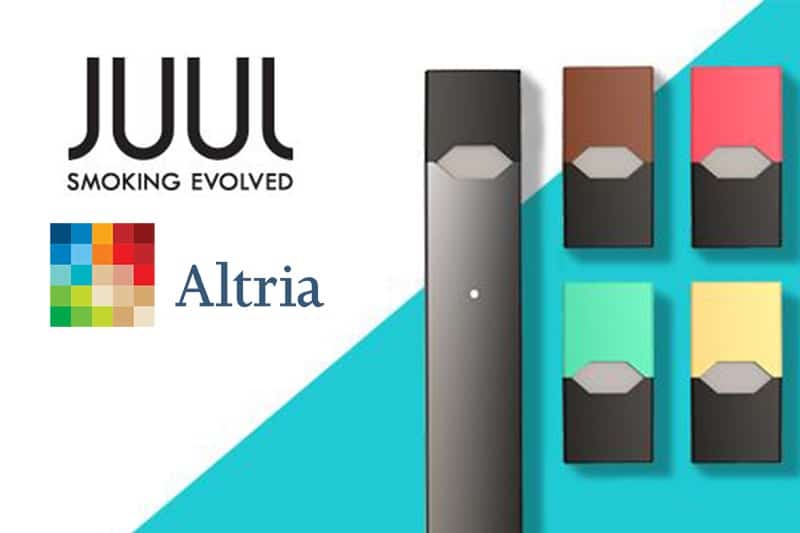
So the tobacco companies have had to “evolve” during these times of change – for whatever reason they may state, but to also keep up with market demand, reduce competitors and at the bottom line keep their profits rolling in.
I personally don’t blame them, I have always thought if I ran a huge Tobacco giant I would have diversified into quality vapes a long time ago. Move with the times, make sure you are well placed in the market during a changeover.
I also believe if the large tobacco giants were part of the alternative nicotine market they would have the power to lobby for less restrictions. This is all without mentioning if they are currently possibly influencing government regulation against their competitors. I bet if their alternative nicotine products had a significant chunk of the market they would be pressuring authorities to de-regulate.
Anyway you can read a more detailed analysis in the whole document here I am just noting the major points discussed.
Responses
So… perhaps @FDATobacco is playing a long game. They assume the #SaferNicotine vape market will be dominated by big tobacco 10 years in the future.
So, by killing off big tobacco’s independent competition now, they’re just hastening that transition?https://t.co/eBa2Xq2IMY
— Charles A. Gardner, PhD (@ChaunceyGardner) January 31, 2023
I think there are forces throughout gov’t and public health determined to ensure that the ecig market is owned big tobacco, also ensuring they remain relavent and perpetually funded to fight them. They see the writing on the wall-ecigs are the death of smoking and tobacco control
— Marc and Bernie (@SeismicPirate) January 31, 2023
I’ve said for years BT will take over small vape. It’s already happening. The biggest bank roll takes the win. While it bothers me & disheartens me that the small vape industry whom moved mountains to save lives will fall; at least we’ll still have harm reduction.
— Mhoward (@VaporUprisingCO) February 1, 2023
Do tobacco companies have an incentive to shift to safer nicotine alternatives? Ironically, that incentive may be lower when the safer market is dominated by independent companies… which, in the USA, @US_FDA is systematically eliminating one-by-one.https://t.co/eBa2Xq2IMY https://t.co/Rojlf9lHL3
— Charles A. Gardner, PhD (@ChaunceyGardner) January 31, 2023
Unfortunately too many countries are restricting competition to cigarettes from less harmful alternatives and push them to the black market…
— Michael Landl (@LandlMichael) January 31, 2023
